German autograph card. Photo: Lothar Winkler.
German postcard by Schorsch und Söhne, Kulmbach.
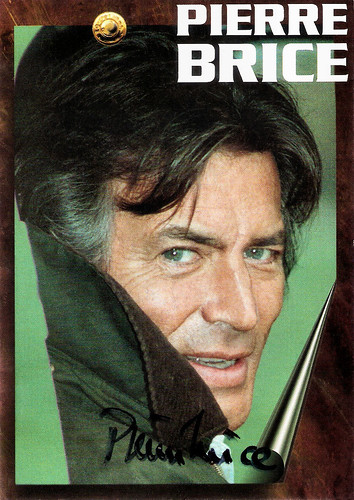
German promotion card by Herz Klang for the record Gefühle. Photo: Frank Wunderlich.
Paratrooper in Indochina
Pierre Brice was born into nobility as Baron Pierre Louis de Bris in Brest, France, in 1929. He was 11 years old when the Nazis invaded France. Since he was brought up as a patriot, he joined his father in the Résistance at age 15. When he was 19, he enlisted as a volunteer in the French Army and fought for four years as a paratrooper in Indochina.
In 1951, Brice returned from the war. He turned his life around and became an actor. He took acting classes from the Russian actor Gregori Chmara. He became a model for advertisements and photo novels, acted as a door-to-door salesman and travelled with a circus.
He got his first small film role in the Eddie Constantine thriller Ça va barder/Give 'em Hell (John Berry, Jacques Lamare, 1955). Bigger roles followed in French productions like Les Tricheurs/Youthful Sinners (Marcel Carné, 1958), but his career in France wasn't likely to take off.
He simply did not have the same kind of talents and charisma as Alain Delon (to whom he was sometimes compared), nor did his good looks go down too well with the (then booming) Nouvelle Vague.
Brice was more a typical matinée idol, he was well-built and very handsome. He could easily pull off any kind of adventurer and he looked convincingly in period costume. Brice went to Italy, to appear in the Peplums, the Sword and Sandal films and similar adventure films like the Gothic horror shocker Il Mulino delle donne di pietra/Mill of the Stone Women (Giorgio Ferroni, 1960), and the modern-day crime film Il Rossetto/Red Lips (Damiano Damiani, 1960).
German postcard, no. E 74. Photo: Constantin. Publicity Still for Der Schatz im Silbersee/Treasure of Silver Lake (1962).
Dutch postcard by Gebr. Spanjersberg N.V., Rotterdam/Edition Facet Publishers. Photo: Rank Film Publishers (Holland) N.V. Publicity Still for Der Schatz im Silbersee/Treasure of Silver Lake (1962) with Lex Barker as Old Shatterhand.
German postcard, no. ED 52. Photo: Constantin. Still from Der Schatz im Silbersee/Treasure of Silver Lake (1962).
Winnetou
In 1962 at the Berlin Film Festival, Pierre Brice met the German producer Horst Wendlandt, head of Rialto Film. Wendlandt searched for an actor to play a Native American chief in Der Schatz im Silbersee/Treasure of Silver Lake (Harald Reinl, 1962).
Blogger Mike Haberfelner wonders why Wendlandt thought that Pierre Brice would be right for the role: "Sure, Brice was a suitably handsome actor for such a role and he had proven himself as a heroic lead time and again, but he was also almost unknown in Germany and he looked nothing like a Native American."
Brice gave a passionate interpretation of Winnetou, and according to Haberfelner his impact easily overshadowed his co-star, Hollywood veteran Lex Barker, who as Old Shatterhand was first-billed in the credits.
Der Schatz im Silbersee was the first filmisation of a novel by Karl May (1842-1912) set in the American West. Earlier films after his novels, like Die Teufelsanbeter/The Devil Worshippers (Marie Luise Droop, 1920) and Die Sklavenkarawane/The Caravan of Slaves (Georg Marischka, Ramón Torrado, 1958), were all set in the Near East.
Der Schatz im Silbersee was a co-production of Germany, Yugoslavia and France. The principal shooting took place in the national park Paklenica Karst River Canyon, Yugoslavia now Croatia. Marianne Hoppe had her first international film role, and for the laughs Eddi Arent (Lord Castlepool) and Ralf Wolter (Trapper Sam Hawkins) appeared. British actor Herbert Lom was cast as a bad colonel, but his performance was restricted by the script.
German postcard, no. ED 51. Photo: Constantin. Still from Der Schatz im Silbersee (1962).
German postcard, no. ED 62. Photo: Constantin. Still from Der Schatz im Silbersee (1962).
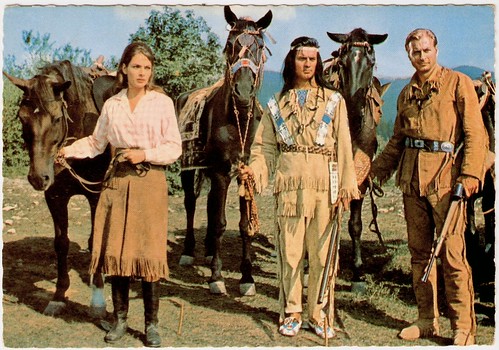
Karin Dor, Lex Barker and Pierre Brice in Der Schatz im Silbersee. German postcard, no. ED 64. Photo: Constantin. Still from Der Schatz im Silbersee (1962).

Dutch postcard by Facet Publishers, Lunteren, no. 4. Photo: Rank Film Distributors (Holland) N.V. Publicity still from Der Schatz im Silbersee (1962).
A superstar in West Germany
Der Schatz im Silbersee has a larger-than-life, fairytale-like atmosphere that attracted a huge audience. It was the very first German film to receive the Goldene Leinwand (Golden Screen), for having over 3 million visitors within 12 months.
The film also received the Bambi-award 1963 as best box-office production. It received furthermore a sum of 200.000 DM from the government as a film prize.
The Old Shatterhand-Melodie, the title melody played on the harmonica by René Giessen and composed by Martin Böttcher, was the most successful track in the German hit parade during the 1960s. It stayed there for several months and over 100,000 copies were sold.
At that time this was very unusual, especially for a film music track without any singers. The music was accompanied by members of the symphony orchestra of the Norddeutscher Rundfunk. Later the theme was recorded as a vocal track by several singers, including a version by Pierre Brice.
Suddenly, Pierre Brice, who was virtually unknown in his home country and was barely holding his own in Italy, was a superstar in West Germany.

German postcard, no. E 32. Photo: Constantin. Pierre Brice in Winnetou - 1. Teil/Apache Gold (Harald Reinl, 1963). Caption: According to the old Apache custom, only the chief and his children are allowed to enter the treasury. Winnetou takes the rear guard with watchful eyes.
Pierre Brice and Hrvoje Svob. German postcard, no. E 14. Photo: Constantin. Still from Winnetou I/Winnetou (1963).
German postcard, no. E 5. Photo: Constantin. Still from Winnetou I/Winnetou (1963).
Blood brothers
Der Schatz im Silbersee was the first Winnetou Western, but it is set in time after the next film in the Winnetou series, Winnetou – 1. TeilApache Gold (Harald Reinl, 1963), again with a music score by Martin Böttcher.
Winnetou – 1. Teil also starred Marie Versini as Winnetou's sister, Mario Adorf as the main villain and Croatian beauty Dunja Rajter.
The film depicts the first meeting of Winnetou and Old Shatterhand, but initially, they find themselves fighting on opposite sides, and it takes the whole film (and a love story between Old Shatterhand and Winnetou's sister) until they realize each other's righteousness and become friends and blood brothers.
Pierre Brice would go on to portray Winnetou in a total of eleven films, alongside alternatively Lex Barker (Old Shatterhand in 7 films), Stewart Granger (Old Surehand in 3 films), and Rod Cameron (1 film) as the white heroes.
All these Westerns were based on the Karl May books and were produced between 1962 and 1968.
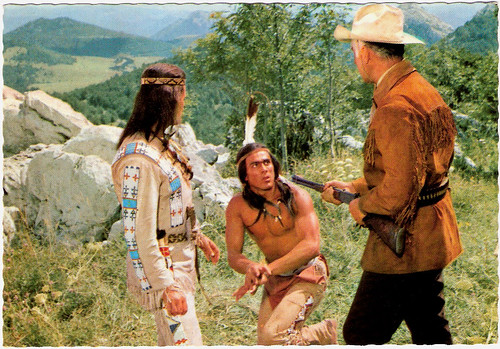
Pierre Brice, Stewart Granger and Gojko Mitic. German postcard, no. 10. Photo: Constantin. Publicity still for Unter Geiern/Among Vultures (1964).

German postcard, no. 35. Photo: Constantin. Publicity still for Unter Geiern/Among Vultures (1964).
German postcard, no. 40. Photo: Constantin. Publicity still for Unter Geiern/Among Vultures (1964).
Peplum spectacle
Pierre Brice appeared also in several other European films like Zorro contro Maciste/Samson and the Slave Queen (Umberto Lenzi, 1963).
He played with Lex Barker in the non-Karl May film Die Hölle von Manitoba/A Place Called Glory (Sheldon Reynolds, 1965) and the James Bond rip-off Schüsse im Dreivierteltakt/Operation Solo (Alfred Weidenmann, 1965).
They also co-starred in the Peplum spectacle Dacii/The Dacians (Sergiu Nicolaescu, 1967) with Marie-José Nat.
In the anthology film Gern hab' ich die Frauen gekillt/Le Carnaval des barbouzes/Killer's Carnival (Sheldon Reynolds a.o., 1966) Stewart Granger.
Lex Barker and Pierre Brice finally worked together - but for some reason, the three actors did not share a single scene in the film.

German postcard, no R 8. Photo: publicity still for Winnetou 2. Teil/Last of the Renegades (Harald Reinl, 1964) with Karin Dor.
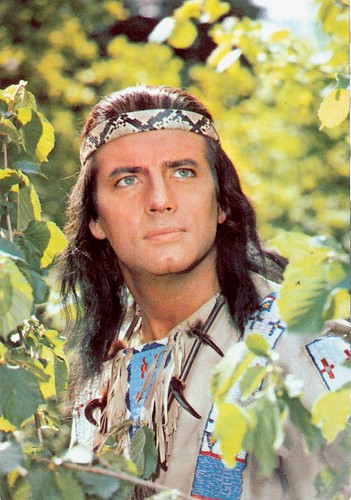
German postcard by ISV, no. R 14. Photo: publicity still for Winnetou 2. Teil/Last of the Renegades (1964).

Karin Dor and Pierre Brice. German postcard, no. R 24. Photo: still from Winnetou - 2. Teil/Last of the Renegades (1964).
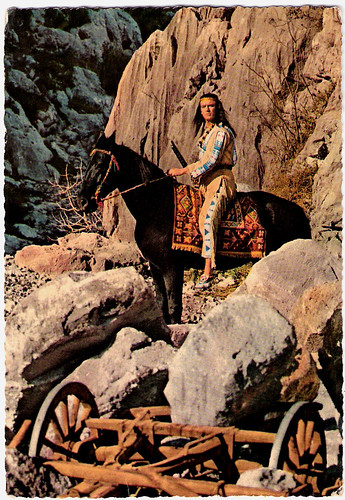
German postcard by Krüger. Photo: Bernard of Hollywood / CCC Produktion. Publicity still for Old Shattterhand (1964). Sent by mail in Luxemburg in 1966.

Lex Barker. German postcard by Kruger. Photo: Bernard of Hollywood (Bruno Bernard) / CCC-Produktion. Publicity still for Old Shatterhand (1964).
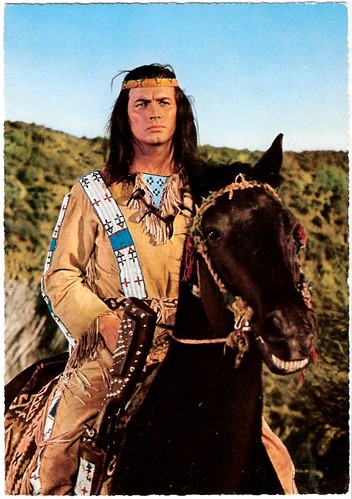
German postcard by Kruger. Photo: Bruno Bernard / CCC Produktion. Publicity Still for Old Shatterhand (1964).
During the 1970s, Pierre Brice played supporting parts in films like the crime comedy La Pupa del Gangster/Get Rita (Giorgio Capitani, 1975), starring Marcello Mastroianni and Sophia Loren.
He also appeared in several TV shows like the Sci-Fi series Star Maidens (1976). But he will always be best remembered as Winnetou, whom he also played at the Karl May Festspiele in Elspe (1977-1986) and at the Bad Segeberg open-air theatre, dedicated only to productions of Karl May shows (1988-1991).
In 1979 he played Winnetou - with Siegfried Rauch as Old Shatterhand - in the TV series Winnetou le mescalero/My Friend Winnetou (Marcel Camus, 1980), which did not originate from Karl May material.
At age 69, he again acted in – and co-scripted - a TV mini-series Winnetous Rückkehr/Winnetou's Return (Marijan David Vajda, 1998), which met devastating criticism.
In 2015, the 86-year-old Brice was admitted to a hospital with a high fever from a lung infection and he died there in the arms of his wife, Hella Krekel. The pair, who lived for three decades in a country house 60 kilometres from Paris, had long been planning a return to her home state of Bavaria.

German postcard by Rüdel-Verlag. Photo: CCC / Constantin / Bruno Bernard. Publicity Still for Old Shatterhand (1964).
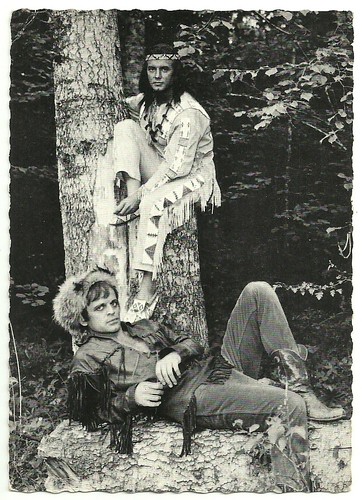
With Klaus Kinski. German postcard by Filmbilder-Vertrieb Ernst Freihoff, Essen. Photo: Lothar Winkler.

Vintage Dutch postcard. With Lex Barker.
US trailer for Il mulino delle donne di pietra/Mill of the Stone Women (1963). Source: CG Entertainment (YouTube).
Trailer for Winnetou - 2. Teil/Last of the Renegades (1964). Source: RialtoFilm (YouTube).
Sources: Mike Haberfelner ((Re)search My Trash), Deutsche Welle, Wikipedia and IMDb.
This post was last updated on 10 August 2023.
In the anthology film Gern hab' ich die Frauen gekillt/Le Carnaval des barbouzes/Killer's Carnival (Sheldon Reynolds a.o., 1966) Stewart Granger.
Lex Barker and Pierre Brice finally worked together - but for some reason, the three actors did not share a single scene in the film.

German postcard, no R 8. Photo: publicity still for Winnetou 2. Teil/Last of the Renegades (Harald Reinl, 1964) with Karin Dor.

German postcard by ISV, no. R 14. Photo: publicity still for Winnetou 2. Teil/Last of the Renegades (1964).

Karin Dor and Pierre Brice. German postcard, no. R 24. Photo: still from Winnetou - 2. Teil/Last of the Renegades (1964).

German postcard by Krüger. Photo: Bernard of Hollywood / CCC Produktion. Publicity still for Old Shattterhand (1964). Sent by mail in Luxemburg in 1966.
Lex Barker. German postcard by Kruger. Photo: Bernard of Hollywood (Bruno Bernard) / CCC-Produktion. Publicity still for Old Shatterhand (1964).

German postcard by Kruger. Photo: Bruno Bernard / CCC Produktion. Publicity Still for Old Shatterhand (1964).
Karl May shows
During the 1970s, Pierre Brice played supporting parts in films like the crime comedy La Pupa del Gangster/Get Rita (Giorgio Capitani, 1975), starring Marcello Mastroianni and Sophia Loren.
He also appeared in several TV shows like the Sci-Fi series Star Maidens (1976). But he will always be best remembered as Winnetou, whom he also played at the Karl May Festspiele in Elspe (1977-1986) and at the Bad Segeberg open-air theatre, dedicated only to productions of Karl May shows (1988-1991).
In 1979 he played Winnetou - with Siegfried Rauch as Old Shatterhand - in the TV series Winnetou le mescalero/My Friend Winnetou (Marcel Camus, 1980), which did not originate from Karl May material.
At age 69, he again acted in – and co-scripted - a TV mini-series Winnetous Rückkehr/Winnetou's Return (Marijan David Vajda, 1998), which met devastating criticism.
In 2015, the 86-year-old Brice was admitted to a hospital with a high fever from a lung infection and he died there in the arms of his wife, Hella Krekel. The pair, who lived for three decades in a country house 60 kilometres from Paris, had long been planning a return to her home state of Bavaria.
German postcard by Rüdel-Verlag. Photo: CCC / Constantin / Bruno Bernard. Publicity Still for Old Shatterhand (1964).

With Klaus Kinski. German postcard by Filmbilder-Vertrieb Ernst Freihoff, Essen. Photo: Lothar Winkler.
Vintage Dutch postcard. With Lex Barker.
US trailer for Il mulino delle donne di pietra/Mill of the Stone Women (1963). Source: CG Entertainment (YouTube).
Trailer for Winnetou - 2. Teil/Last of the Renegades (1964). Source: RialtoFilm (YouTube).
Sources: Mike Haberfelner ((Re)search My Trash), Deutsche Welle, Wikipedia and IMDb.
This post was last updated on 10 August 2023.
1 comment:
Brice rodó "Los atracadores", 1961, de Rovira Veleta, basada en la novela de Tomás Salvador
Post a Comment